How do shifts in population change a place?
Ireland sent immigrants to the American colonies early in their settlement. Charles Carroll was a signer of the Declaration of Independence. In the 1840s, the Irish potato sent waves of migrants who could afford passage fleeing starvation in the countryside. The Irish made up one half of all migrants to the country during the 1840s. From 1820 to the start of the Civil War, they constituted one third of all immigrants. Early in the century, the majority of Irish immigrants were single men. After the 1840s, the pattern shifted to families as a few family members came first and earned money to bring relatives later in a process known as chain migration. In later years, women provided the majority of new arrivals.
Irish Immigrants in America
So harsh were conditions in Ireland that the nation's population decreased substantially through the 19th century. From 8.2 million in 1841, the population dropped to 6.6 million in only ten years and to 4.7 million in 1891. From 1841 to World War II, some estimates conclude that 4.5 million Irish came to the United States.
While not all Irish migrants were poor, most were. Many did not have money to move beyond the eastern port where they landed, and their numbers soon swelled cities like New York and Boston. Many found the adjustments from their rural backgrounds to the impersonal urban environments very difficult. They crowded into low-cost housing creating problems for schools, disease and sanitation. Men took whatever jobs they could find, usually at very low pay, while women became domestic workers or other low paying jobs. Often they found themselves competing for jobs with African Americans for work that was the hardest, most dangerous and lowest paying. Employers used the Irish, as well as other newly-arrived immigrants and African Americans, to threaten replacement of workers if they advocated for better working conditions, which created ethnic tensions that sometimes broke out into violence.
In addition to economic pressures, the Irish also faced religious discrimination. Centuries of conflicts between Protestants and Catholics followed immigrants to the United States, and the Irish Catholic faced hostility from the longer-settled Protestants who feared that the growing numbers of Irish would translate into political power. And it did. As politicians learned to court Irish voters, urban political machines rewarded their supporters with public jobs like policemen, firemen, sanitation workers and road crews. Protestant groups gravitated toward the Republican Party that sometimes promoted discriminatory laws like voting restrictions or the prohibition of the sale and use of alcohol. In response, Catholic immigrants like the Irish became the heart of the Democratic Party in many Northern states.
The Irish in Iowa
In Iowa, the Irish were the second largest immigrant group, topped only by the Germans. They settled in large numbers in the Mississippi River towns like Dubuque and Davenport. The Catholic bishop in Dubuque encouraged Irish and German Catholic immigration to Iowa and directed new arrivals to communities in northeast Iowa where they could be served by Catholic priests. Within the church itself, there was often competition to bring an Irish or German priest to serve the congregation. The railroads needed manual laborers and recruited the Irish to lay the rails and maintain the trains in roundhouses, bringing workers to small towns. The Irish also settled together in towns like Emmetsburg and in rural neighborhoods. They often supported private schools so that they could teach their children in a Catholic environment.
During World War I, German-Americans were often the targets of abuse or discrimination. The Irish came under some pressures, too. They resented the centuries of domination by Great Britain, a U.S. ally. In the 1920s, Protestant-Catholic tensions produced a revival of the Ku Klux Klan to "protect American values" against the rise of "foreign threats" like the Irish and other immigrants, but the organization lost steam by the end of the decade. World War II did much to quiet ethnic tensions at home as America united to fight Germany and Japan.
Supporting Questions
What factors led to migration from Ireland to North America?
- "Cause of the Non-Commencement of the Rebellion in Ireland," November 15, 1848 (Document)
- "The Irish Mother," April 19, 1849 (Document)
- "Poor Ireland," June 21, 1849 (Document)
- "Curious Facts," May 9, 1851 (Document)
- Chapter XIX from "A History of the Irish Settlers in North America from the Earliest Period to the Census of 1850," 1852 (Document)
- "Emigrants leaving Queenstown [Ireland] for New York," 1874 (Image)
How did the migration of Irish people impact the United States and Ireland?
- "Ireland," November 27, 1851 (Document)
- Chapter XXV from "A History of the Irish Settlers in North America from the Earliest Period to the Census of 1850," 1852 (Document)
- "The Foreign Element," February 8, 1855 (Document)
How did Americans respond to immigrants?
- "Wanted - An American or English Girl" Newspaper Advertisement, August 24, 1842 (Document)
- "Coachman Wanted" Newspaper Advertisement, May 14, 1852 (Document)
- "The Irish Problem," November 5, 1854 (Document)
- "Which Color is to be Tabooed Next?" 1882 (Political Cartoon)
| Irish Immigration: Beyond the Potato Famine Teaching Guide |
| Printable Image and Document Guide |
"Cause of the Non-Commencement of the Rebellion in Ireland," November 15, 1848

Description
This article from 1848 describes the progression of rebellion in Ireland and the factions that developed between those who wanted to use violence and those who did not. The author explains the causes for both the rebellion and the conflict. The author hints at chaos created…
"The Irish Mother," April 19, 1849
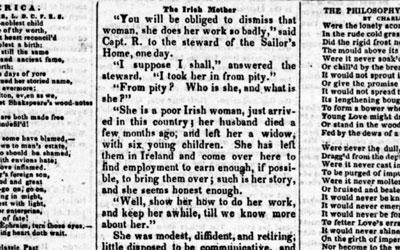
Description
This 1849 article appeared in the Burlington Tri-Weekly Hawk-Eye. It tells the story of an Irish mother who left her children in poverty in Ireland to go to America and earn money so the whole family could immigrate. The article relates a heart-warming end to the…
"Poor Ireland," June 21, 1849
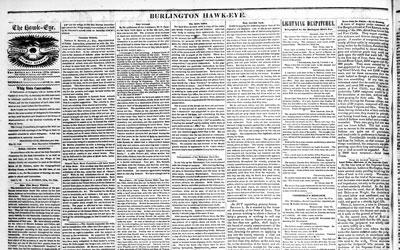
Description
This article from the Burlington Tri-Weekly Hawk-Eye in 1849 gives a dark picture of Ireland. The author states that the information being relayed is a month old and that conditions in Ireland are as bad as they have ever been. He states that starvation…
"Curious Facts," May 9, 1851
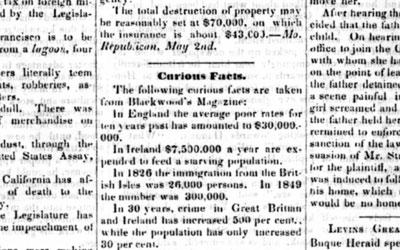
Description
This article published in the Des Moines Courier is from 1851. It is taken from the British publication, Blackwood's Magazine. The article highlights statistics about the British Isles relating to crime, hunger, immigration and poverty.
Chapter XIX from "A History of the Irish Settlers in North America from the Earliest Period to the Census of 1850," 1852
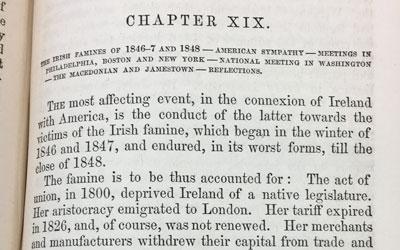
Description
Thomas McGee wrote this book in 1852 describing the experiences of the Irish in the United States. McGee was in a unique position to write this book. He was involved in a plot to create a revolution in Ireland, but moved to the United States when it failed. After a time, he…
"Emigrants leaving Queenstown [Ireland] for New York," 1874
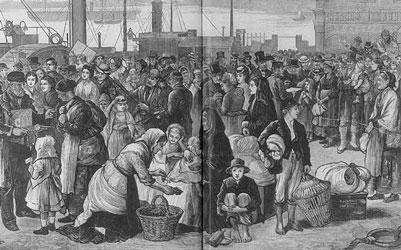
Description
This engraving from 1874 depicts a scene of the Irish preparing to embark on a ship headed to New York. The artist shows people of all classes of society and various levels of enthusiasm about the voyage. The 1874 scene shows that people continued to leave Ireland and…
"Ireland," November 27, 1851
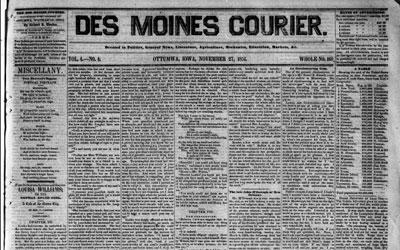
Description
This newspaper article from 1851 describes a desperate situation in Ireland, which is rapidly losing population. The letter originally appeared in the Limerick Chronicle and was reprinted in the Des Moines Courier.
Chapter XXV from "A History of the Irish Settlers in North America from the Earliest Period to the Census of 1850," 1852
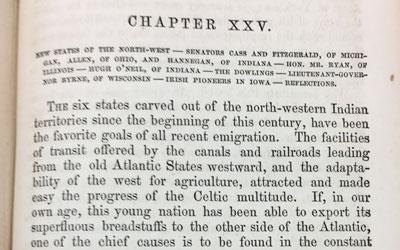
Description
Thomas McGee was an Irish immigrant to America who wrote about the experiences immigrants had. He eventually moved to Canada because he didn't think the Irish would ever be treated fairly in the United States. His book chronicled the state of the Irish.
"The Foreign Element," February 8, 1855

Description
This Burlington Tri-Weekly Hawk-Eye newspaper article from 1855 details the statistics regarding immigrants from Germany and Ireland. It gives information regarding the jobs immigrants performed.
"Wanted - An American or English Girl" Newspaper Advertisement, August 24, 1842

Description
This "Wanted" advertisement from the New-York Daily Tribune in 1842 is for a servant to do housework. It specifically says that people from Ireland should not apply.
"Coachman Wanted" Newspaper Advertisement, May 14, 1852
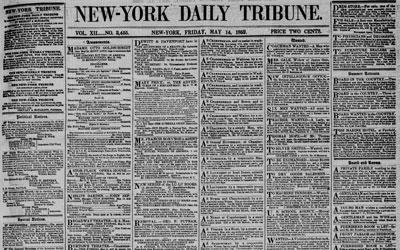
Description
Wanted advertisements in newspapers throughout the Antebellum period explicitly told jobseekers who was and who was not an acceptable applicant. This ad is noteworthy because, during the tumultuous 1850s, it shows several distinct prejudices.
"The Irish Problem," November 5, 1854
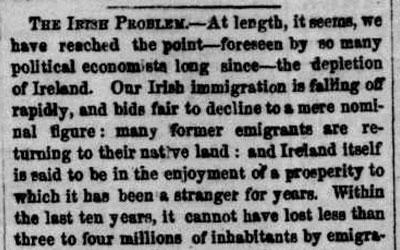
Description
This article from The New York Herald in 1854 describes a decline in immigration from Ireland. The author hints that this could potentially lead to a shortage of labor in the United States. The author, however, believes that unrest in Germany will likely lead…
"Which Color is to be Tabooed Next?" 1882
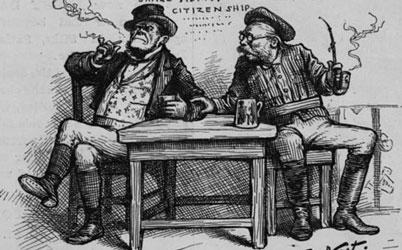
Description
This political cartoon by famed political cartoonist, Thomas Nast, was published in 1882 in response to the Chinese…
Additional Resources
- "The Irish in Iowa," Palimpsest, Vol. 45, No. 2, February 1964
The Palimpsest was a historical magazine published the State Historical Society of Iowa beginning in 1920 until it was renamed Iowa Heritage Illustrated in 1996. This February 1964 edition focuses on the history of the Irish in Iowa, such as the "Exodus to America," "Encouragement to Move West" and "The Irish in Politics."
Iowa Core Social Studies Standards (6th Grade)
Listed below are the Iowa Core Social Studies content anchor standards that are best reflected in this source set. The content standards applied to this set are middle school-age level and encompass the key disciplines that make up social studies for students in the sixth grade.
| No. | Standard Description |
| SS.6.19. | Explain how global changes in population distribution patterns affect changes in land use in particular countries or regions. |
| SS.6.20. | Analyze connections among historical events and developments in various geographic and cultural contexts. |
| SS.6.22. | Explain multiple causes and effects of events and developments in various geographic and cultural contexts. |